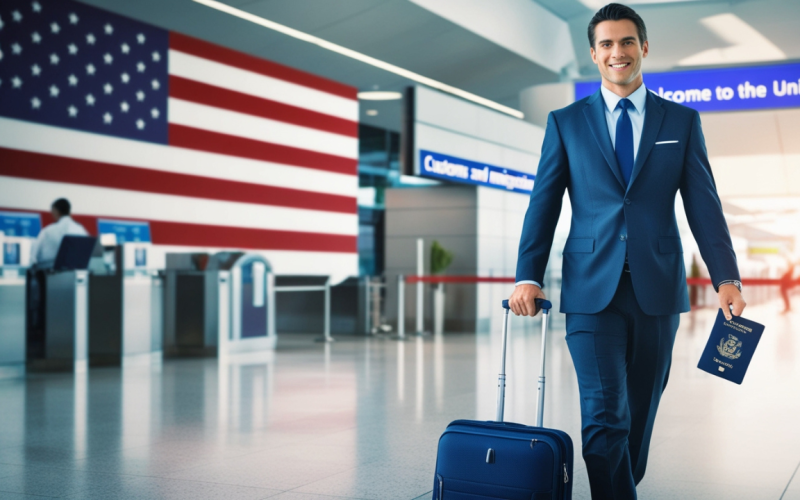Travelling to the United States can be an exciting adventure, whether it’s your first time or you’re a seasoned traveller. From world-renowned cities like New York and Los Angeles to stunning national parks and unique cultural experiences, the U.S. has something for every type of traveller.
However, the sheer size of the country, as well as its specific entry requirements and cultural norms, means there’s a lot to consider before you go. Being well-prepared ensures your trip is smooth, safe, and enjoyable.
This guide covers all essential travel tips, from preparing documents to safety guidelines, so you’ll be fully prepared to navigate your U.S. adventure with confidence.
Key Takeaways
- Make sure you have a valid passport and any necessary visas or travel authorizations.
- Consider purchasing comprehensive travel insurance for health and safety coverage.
- Understand U.S. entry and exit requirements, especially under the Visa Waiver Program.
- Familiarize yourself with safety precautions and health guidelines, including resources for emergencies.
- Plan your travel itinerary thoughtfully, keeping weather, health alerts, and cultural norms in mind.
Preparing for Your Trip to the USA
Essential Documents for Entry
Entering the United States requires that you have certain documents ready to ensure smooth entry. The primary document is your passport, which should be valid for at least six months beyond your planned departure date. Additionally, depending on your country of citizenship, you may need to obtain a visa or secure travel authorization through the Electronic System for Travel Authorization (ESTA).
Visa Requirements & ESTA
For citizens of countries eligible for the Visa Waiver Program (VWP), travel to the U.S. is typically more straightforward. Under this program, eligible travelers can enter the U.S. for up to 90 days without a visa, provided they have received approval through ESTA. However, ESTA authorization must be completed at least 72 hours before your flight, so it’s crucial to plan ahead.
Visa Types and Requirements:
- Tourist Visa (B-2): For those not covered under the VWP, the B-2 tourist visa is a common option.
- Business Visa (B-1): Required for short business trips and meetings.
Each visa type has specific eligibility criteria, so visit the U.S. Citizenship and Immigration Services (USCIS) website for detailed instructions. Keep your I-94 form (which records your arrival and departure) if your stay extends beyond the initial period. You may need it if you apply to extend your stay.
Customs and Border Protection Rules
Upon arriving at your port of entry in the U.S., you will be inspected by Customs and Border Protection (CBP) officers. They may ask about the purpose of your visit and your travel plans and request to see any documentation, including proof of onward travel.
It’s important to answer questions truthfully and to carry any valuable items or cash in declared amounts as per customs rules. Failure to declare items, such as live animals or valuable personal goods, can result in penalties.
Comprehensive Travel Insurance
Why Travel Insurance is Essential
The U.S. healthcare system is among the most advanced but also one of the most expensive globally. For travellers, an unexpected illness or injury can result in hefty medical bills, especially without insurance. It’s strongly recommended to purchase comprehensive travel insurance before departure, as it can provide peace of mind in the event of medical emergencies, accidents, or trip disruptions.
What Should Your Insurance Policy Cover?
When purchasing travel insurance, ensure your policy covers the following:
- Emergency Medical Treatment: This covers the cost of immediate medical care, which can be critical if you encounter health risks such as flu outbreaks or dengue in warmer climates.
- Medical Evacuation: If you require specialized treatment unavailable locally, medical evacuation coverage will be invaluable.
- Loss or Theft: Protection against lost luggage, theft, or even loss of travel documents.
Be sure to carry proof of insurance in both physical and digital formats, as U.S. healthcare providers often require proof of your ability to pay.
Essential Travel Insurance Coverage for the U.S.
| Coverage Type | Description | Importance |
|---|---|---|
| Emergency Medical Care | Covers costs of immediate treatment for injuries or illnesses. | Essential due to high healthcare costs in the U.S. |
| Medical Evacuation | Covers the cost of transportation to a better medical facility. | Important for areas lacking advanced medical facilities |
| Loss or Theft Protection | Insures valuables, documents, and personal items against loss/theft. | Provides financial security for lost items or documents |
| Trip Disruption Coverage | Reimburses costs for canceled or delayed flights. | Useful for minimizing financial loss due to travel delays or cancellations |
Preparing Your Travel Itinerary
Planning a Well-Rounded Itinerary
The U.S. spans a vast geographical area, which means climates, cultures, and attractions can vary significantly from state to state. Whether you plan to explore the beaches of Florida, the mountains in Colorado, or the cityscape of New York, having a clear itinerary is helpful.
Start by listing the 50 states and territories (such as Puerto Rico) that you’re interested in visiting, and research weather conditions, safety advisories, and local customs for each area.
Travel Alerts and Health Warnings
Stay updated on travel alerts by signing up for notifications from trusted sources like the Centers for Disease Control (CDC), which offers the latest information on health risks. Severe weather events, such as hurricanes or wildfires, can occur with little notice, so it’s important to monitor conditions, particularly if you’re visiting urban or rural areas that may be impacted. Having this knowledge ensures that you’re prepared for any necessary changes to your travel plans.
Entry and Exit Requirements
Entry Requirements to the USA
To enter the United States smoothly, you’ll need to follow specific entry requirements established by U.S. authorities. Upon arrival, have your travel documents ready and be prepared for a brief interview. This is where Customs and Border Protection officials will check your passport, visa, or ESTA, and ask routine questions about the purpose of your visit.
I-94 Form and Port of Entry Procedures
If you’re staying for an extended period, ensure you complete the I-94 form upon entry, as it keeps a record of your arrival and stay period. CBP officers may also inspect your belongings and ask questions about your visit. To avoid complications, follow instructions from local authorities and adhere to any specific regulations regarding prohibited items.
Following Local Authorities’ Instructions
For your safety, it’s important to comply with the instructions given by local officials. These instructions may include adhering to public safety guidelines or responding to national terrorism advisory system alerts. While the likelihood of encountering a terrorist event is low, awareness of these resources can provide reassurance.
Safety, Security, and Health Precautions
Safety and Security Tips
When visiting the U.S., it’s essential to prioritize personal safety. While most areas are safe for tourists, being aware of potential risks ensures a worry-free trip. The United States has an effective public alert system, which includes updates on severe weather, public safety concerns, and other potential hazards.
Awareness of Violent Crime and Terrorism Alerts
In urban areas, there may be occasional reports of violent crime. Check for National Terrorism Advisory System alerts, particularly if visiting crowded areas or public events. Awareness of the latest updates can help you make informed choices. While incidents are rare, staying informed helps you be better prepared, especially in high-profile locations.
Emergency Contacts and Precautions
In emergencies, contact local authorities immediately. Each embassy or consulate offers consular assistance in case of emergencies or lost documents. Always have emergency contacts on hand, including Consular Services in the U.S., to provide support in unforeseen situations.
Health and Safety Resource Contacts
| Organization | Purpose | Contact Information |
|---|---|---|
| U.S. Department of Homeland Security | Provides updates on travel security and entry requirements. | www.dhs.gov |
| Centers for Disease Control (CDC) | Health advisories, disease prevention, and travel health tips. | www.cdc.gov |
| U.S. Consulate and Embassy Services | Assists in emergencies, lost documents, and consular support. | Refer to specific embassy sites |
| National Weather Service (NWS) | Offers alerts for severe weather and safety precautions. | www.weather.gov |
Health and Medical Care in the United States
Emergency Medical Services and When to Use Them
Understanding when and how to access emergency medical services can be essential during your stay in the U.S. In the event of a serious health issue, the U.S. has a highly responsive 911 emergency service system, which can dispatch ambulances, firefighters, or police, depending on the situation.
However, it’s worth noting that ambulance and emergency room services are typically costly, so reserving them for genuine emergencies is best. Familiarizing yourself with nearby urgent care centres, which can handle minor to moderate health issues, is a helpful step, as these centres are often a more affordable alternative to emergency rooms.
Using Urgent Care Centers and Pharmacies for Non-Emergencies
In addition to hospitals, the U.S. has many urgent care centers, which are designed to handle non-life-threatening health concerns, such as minor injuries or illnesses. These centres are usually faster and more affordable than emergency rooms, making them a practical option for travellers.
Many pharmacies are also equipped to help with minor health issues, vaccinations, and medication refills. Large chains, such as CVS and Walgreens, offer basic healthcare services and are widely available in urban and suburban areas.
Recommended Vaccinations and Preventive Health Measures
Before visiting the U.S., it’s a good idea to ensure that your routine vaccinations, such as tetanus, measles, and flu shots, are up to date. Some travellers may also need additional vaccines based on their planned activities and regions of travel.
The CDC provides a list of recommended vaccines for international travelers and may suggest certain vaccinations depending on the season, region, and types of activities planned. Preventive health measures, such as good hand hygiene and proper hydration, also contribute to a healthy travel experience.
Finding Healthcare Facilities that Accept Foreign Insurance
Not all healthcare facilities in the U.S. accept foreign insurance, which can make navigating the system challenging for international travelers. Before visiting, check with your insurance provider to identify hospitals, clinics, or urgent care centres that accept international or travel insurance policies.
Major urban centers and tourist areas are more likely to have facilities that accept international insurance; however, in rural or less frequented areas, you may need to confirm beforehand or be prepared to pay out of pocket and submit for reimbursement later.
Tips for Managing Prescription Medications While Traveling
If you are bringing prescription medications, ensure they are in their original, labelled containers, as U.S. customs officials may need to verify the contents. It’s helpful to carry a copy of your prescription and a letter from your doctor explaining the necessity of each medication, especially for controlled substances.
For longer stays, confirm that your medication is available in the U.S., as certain prescriptions may have different regulations or may not be available without a local doctor’s prescription. Some pharmacies also offer same-day delivery of prescriptions, particularly in urban areas.
Medical Evacuation and Repatriation: Planning for Serious Health Events
Medical evacuation and repatriation coverage can be critical in severe medical cases. This type of insurance covers the cost of transporting you to the nearest appropriate medical facility or, in some cases, returning you to your home country for treatment.
Medical evacuation can be costly, often amounting to thousands of dollars if you need specialized transportation. Having evacuation coverage within your insurance plan protects you from these high costs and ensures you receive the care you need promptly.
Mental Health Resources for Travelers
Travelling can sometimes lead to stress, anxiety, or other mental health challenges, particularly if you encounter unexpected events or travel-related issues. The U.S. has many mental health resources, including hotlines, counselling centres, and telehealth options, which can be accessed if needed.
Many travel insurance plans now include mental health support, such as virtual therapy sessions or access to licensed counselors. Familiarize yourself with these resources beforehand, as managing mental health can be just as important as physical health during your travels.
Important Healthcare Contacts for International Visitors
Having access to important healthcare contacts can streamline assistance in case of an emergency. Aside from 911 for emergencies, travellers should know the locations and contact information for nearby hospitals, urgent care centres, and their insurance company’s emergency hotline.
Some countries also have embassies or consulates with designated health representatives who can offer guidance and help coordinate medical assistance. Ensure these contacts are stored in an easily accessible format, such as on your phone or in a printed document.
Navigating Language Barriers in Healthcare Settings
English is the primary language used in U.S. healthcare facilities, but many larger hospitals and urban clinics offer translation services for international visitors. If you’re more comfortable speaking in another language, you can request interpreter services at most major healthcare facilities, though it’s wise to inquire in advance if language support is available.
Translation apps or written documentation in both English and your native language can also be useful for communicating specific symptoms or needs with healthcare providers.
Practical Travel Tips for a Comfortable Stay
Tips for Navigating U.S. Culture and Customs
Understanding local customs can enhance your travel experience in the U.S. American culture may vary between regions, so knowing a few basic tips can help you feel more at ease.
Tipping and Hospitality Etiquette
Tipping is common in the U.S., particularly in coffee shops, restaurants, and for services like housekeeping in hotels. Most service workers rely on tips, with an average of 15-20% expected in restaurants.
Language and Communication
While English is widely spoken, certain areas, like southern states or cities with diverse populations, may have communities that speak Spanish or other languages. If you need specific information, don’t hesitate to ask locals or consult consular services if language becomes a barrier.
Handling Valuables and Important Documents
Carry essential documents, such as your passport, driver’s license, and proof of insurance, securely. Always keep copies of important travel documents in a safe location. Avoid displaying valuables, particularly in crowded places or urban areas.
Top Destinations in the U.S. and Key Tips for Each
| City | Highlights | Travel Tips |
|---|---|---|
| New York | Times Square, Statue of Liberty, Broadway | Avoid peak hours in popular spots; use public transit. |
| Los Angeles | Hollywood, Santa Monica Pier, Beaches | Plan for traffic delays; explore on foot where possible. |
| Miami | Beaches, Art Deco District, Nightlife | Pack for warm weather; stay hydrated and wear sunscreen. |
| San Francisco | Golden Gate Bridge, Alcatraz Island | Dress in layers; be prepared for changing weather. |
| Las Vegas | Casinos, Shows, Hoover Dam | Stay hydrated; manage budgets as expenses can add up. |
Entry and Exit Procedures for U.S. Travelers
Understanding Entry and Exit Requirements
The U.S. has specific entry and exit regulations for travelers, including re-entry requirements if you plan to travel out of the country and back.
Visa Waiver Program and Re-Entry Requirements
If you are traveling under the Visa Waiver Program (VWP), confirm your eligibility with Citizenship and Immigration Services and make sure your travel plans align with the 90-day limit. For travelers planning to re-enter the United States after visiting neighboring countries, double-check entry rules to avoid poteAdditional Considerations for Business and Long-Term Travelersntial delays.
Exit Requirements and Period of Stay
Your period of stay in the U.S. is often documented on your I-94 form. Exceeding this stay without prior authorization can affect future entries, so ensure your travel plans align with your permitted period. For travelers with a visa, specific exit requirements apply, so confirm any obligations before departure.
Additional Considerations for Business and Long-Term Travelers
Travelers visiting the U.S. for business or extended stays often have unique requirements compared to short-term tourists. These visitors may need to navigate additional regulations, specific visa types, and detailed documentation to ensure compliance with U.S. immigration policies.
Business travelers should understand the relevant rules to avoid issues that could impact their professional engagements. For long-term stays, preparation and knowledge of U.S. policies can help create a smoother experience.
Necessary Documentation for Business Trips
Business travelers should bring all required documentation, including a business visa or equivalent permits, if they intend to engage in professional activities like meetings, training, or short-term projects. The B-1 visa, commonly used for business purposes, allows for limited business activities but does not permit employment within the U.S.
It’s essential to follow U.S. immigration regulations closely, as engaging in unauthorized work or other activities outside the visa’s scope can lead to serious immigration violations, impacting current and future travel to the U.S.
To streamline your experience at the port of entry, be ready to explain the purpose of your visit and provide supporting documentation, such as invitation letters, proof of employment, or itinerary details. U.S. Customs and Border Protection (CBP) officers may ask for these materials, and having them readily available helps establish your intent to comply with visa requirements.
Extending Your Stay for Work Purposes
In some cases, business travelers may need to extend their stay beyond the initial period permitted by their visa. For those wishing to remain in the U.S. longer for professional reasons, U.S. Citizenship and Immigration Services (USCIS) offers options for extending stays or changing visa status. Applying for an extension or status change can allow for a temporary extension of your professional activities, provided you meet eligibility requirements.
My Opinion
In my opinion, traveling to the United States is an incredible experience, but preparation is key. The high standards of healthcare come with significant costs, making travel insurance essential to avoid unexpected expenses. Being aware of regional health risks and having emergency contacts readily available provides peace of mind.
Access to urgent care centers and pharmacies adds convenience for minor health issues, while medical evacuation coverage ensures support in serious cases. Overall, understanding the U.S. healthcare system and taking preventive measures allows travelers to enjoy their visit safely and confidently.







